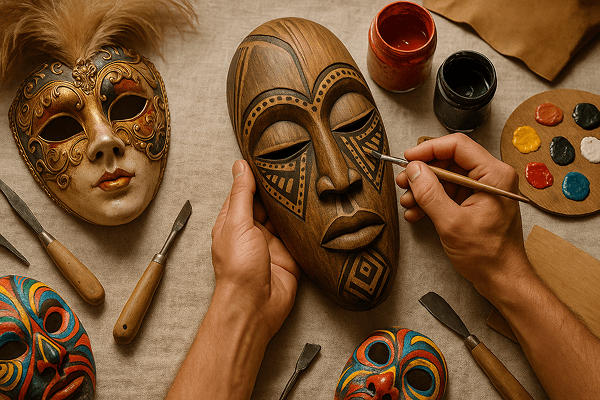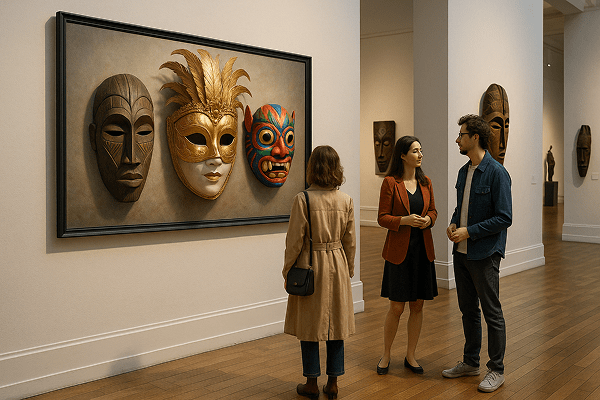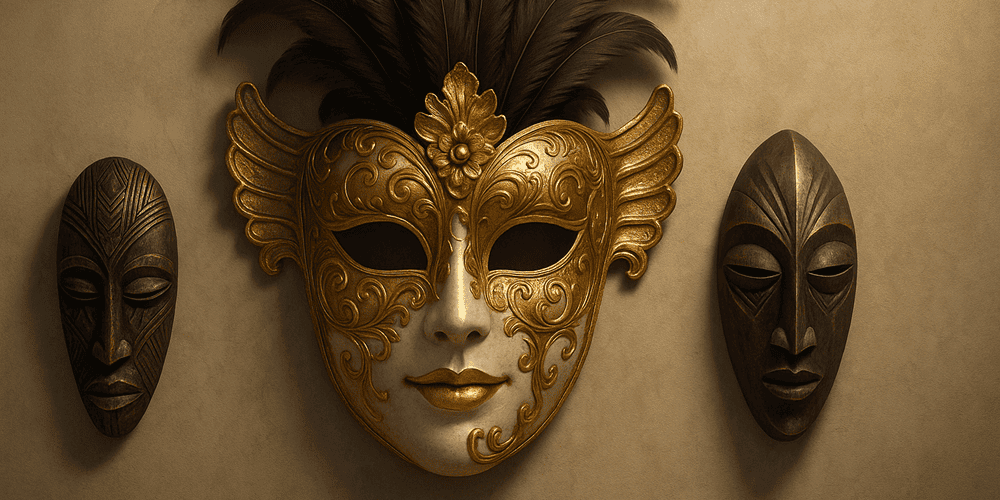Decorative Wall Masks are striking art objects designed to adorn interior spaces, serving both aesthetic and cultural functions. These masks are distinguished by their visual diversity — from minimalist modern designs to ornate traditional forms. They may feature carved wood, painted ceramics, glass, metal, or mixed media, often with intricate patterns, vibrant colors, and expressive faces or abstract motifs. Wall Masks can be found in homes, galleries, offices, and public spaces worldwide. While their roots span continents and civilizations, today’s Decorative Wall Masks are a global phenomenon, blending heritage and innovation in the world of interior design. For collectors and enthusiasts, platforms like toddmasks.com offer a window into this rich tradition.
Historical Origins of Decorative Wall Masks
The tradition of wall-mounted masks dates back thousands of years. The word “mask” itself comes from the Latin “masca,” meaning ghost or spirit, reflecting the mystical origins of masking. Ancient civilizations — from Egypt and Greece to China and the Americas — used masks in rituals, funerary rites, and public ceremonies, often displaying them on walls as totems or symbols of power.
Over time, the function of masks diversified. While many early masks were wearable for ritual or performance, others were created specifically for display, marking sacred spaces or commemorating ancestors. The transition from ritual artifact to decorative object accelerated during the Renaissance and Baroque periods in Europe, and in the 20th century, artists began creating wall masks purely for artistic expression. Surviving artifacts in museums — such as African wooden wall masks, Venetian papier-mâché masks, and Mexican Day of the Dead masks — illustrate the evolution and enduring appeal of this art form.
Cultural Significance and Symbolism of Decorative Wall Masks
Decorative Wall Masks hold deep symbolic meaning in their cultures of origin. In many African societies, wall masks represent spirits, ancestors, or deities, and are believed to bring protection, fertility, or fortune to the household. In Asia, masks may embody mythological beings or Buddhist icons, serving as guardians or sources of inspiration.
Myths and legends abound — from the Yoruba Egungun spirits to the Japanese Noh demons — with each mask type carrying a story and a social context. In Mexico, wall masks depict gods, animals, or historical figures, linking the family to community and tradition. In modern Western culture, wall masks are often chosen for their expressive power or decorative beauty, but they continue to evoke a sense of mystery, identity, and transformation. The social role of wall masks has expanded to symbolize hospitality, status, or a connection to global heritage.
Materials and Crafting Techniques of Decorative Wall Masks
The creation of Decorative Wall Masks is a testament to artistic skill and material innovation. Traditional materials include carved wood, fired clay, painted ceramics, papier-mâché, metal, leather, and glass. Some cultures use beads, feathers, shells, textiles, or mirrors as embellishments. The crafting process usually involves:
- Sketching or sculpting the mask design
- Carving, molding, or shaping the base material
- Drying, firing, or curing, depending on the medium
- Painting, glazing, or applying surface decoration
- Adding decorative elements and mounting hardware
Special techniques — such as wood-burning, metallic leaf application, mosaic inlay, and mixed-media collage — result in unique textures and finishes. Regional differences are significant: African wall masks may feature bold geometric carving and earth tones, while Venetian wall masks use gilding and vibrant paint. Color symbolism varies by culture, but commonly includes red for vitality, gold for divinity, black for mystery, and blue for protection or tranquility. On toddmasks.com, you can find artisan stories and process videos that reveal the artistry behind wall mask creation.

Functions and Uses of Decorative Wall Masks
Decorative Wall Masks are primarily designed for display, but their uses are diverse:
- Ritual and Ceremonial Use: In some cultures, wall masks are placed in shrines or sacred spaces to honor ancestors or invoke blessings.
- Theatrical Application: Many masks are inspired by or adapted from masks used in traditional theater (such as Japanese Noh or Italian commedia dell’arte).
- Festival and Holiday Decoration: Wall masks are popular during celebrations like Carnival, Day of the Dead, or local harvest festivals.
- Modern Interior Design: Today, wall masks are used to create focal points in homes or commercial spaces, bringing color, texture, and cultural meaning to an environment.
- Gifts and Souvenirs: Smaller wall masks are often given as tokens of friendship or collected as mementos from travels.
Over time, the use of wall masks has shifted from purely religious or ceremonial to include artistic, decorative, and personal expression.
Regional Variations of Decorative Wall Masks
The diversity of Decorative Wall Masks reflects the world’s cultural richness:
- African Wall Masks: Known for sculptural woodwork, symbolic patterns, and spiritual themes, often from West and Central African societies.
- Asian Wall Masks: Include dramatic Noh and Kyogen masks from Japan, fierce Himalayan guardian masks, and ornate Chinese opera masks.
- European Wall Masks: Feature Venetian Carnival Masks with elaborate paint, feathers, and metallic leaf, as well as folk masks from Eastern Europe.
- Latin American Wall Masks: Vibrant Mexican masks for Dia de los Muertos, Guatemalan animal masks, and Peruvian festival masks.
Local specialties may include materials, motifs, or mounting styles unique to a region. Comparing Wall Masks to other Decorative Masks highlights both shared traditions and unique artistic voices.
Famous Examples and Notable Collections of Decorative Wall Masks
Many renowned museums feature world-class collections of Decorative Wall Masks, including:
- The Metropolitan Museum of Art (New York): African, Oceanic, and Asian wall masks
- Museo Nacional de Antropología (Mexico City): Mexican folk and festival masks
- Musée du quai Branly (Paris): Global ceremonial and decorative masks
- The Victoria and Albert Museum (London): European and contemporary art masks
Private collectors and galleries also showcase rare and artist-signed wall masks. Notable historical finds — such as the ancient Judean stone masks or Benin ivory plaques — have deepened our understanding of the mask as both art and artifact. To view curated digital galleries and learn about provenance, visit toddmasks.com.
Influence of Decorative Wall Masks on Art and Culture
Decorative Wall Masks have inspired artists, designers, filmmakers, and musicians around the world. In visual art, they have influenced painting, sculpture, and installation, with modern artists referencing mask motifs in abstract and figurative works. In literature and cinema, masks symbolize identity, secrecy, and transformation. In contemporary design, wall masks are a popular element in eclectic, bohemian, and global-inspired interiors.
Their presence in museum exhibitions and cultural festivals helps preserve mask traditions and foster dialogue between cultures. The influence of Decorative Wall Masks extends into fashion, set design, and even digital media, underscoring their enduring appeal and adaptability.

Contemporary Status and Preservation of the Decorative Wall Mask Tradition
Today, the tradition of wall-mounted masks is thriving, thanks to artisans, designers, and collectors. Modern masters blend traditional techniques with innovative materials — from eco-friendly resins to digital fabrication. Schools and cultural organizations offer mask-making workshops, while online platforms like toddmasks.com provide resources for learning and appreciation.
Preservation efforts include museum conservation, oral history projects, and cultural festivals. Contemporary adaptations range from minimalist Scandinavian designs to bold, experimental art masks. The tradition is kept alive by both established workshops and new generations of artists redefining the boundaries of decorative mask art.
Collecting and Acquiring Decorative Wall Masks
The market for Decorative Wall Masks is active and diverse. Authentic masks can be acquired from galleries, artisan studios, museum shops, and reputable online platforms such as toddmasks.com. Price ranges vary widely, depending on factors such as material, craftsmanship, provenance, age, and artist reputation.
Tips for collectors:
- Look for quality materials and expert craftsmanship
- Seek provenance or documentation for valuable pieces
- Support living artisans and fair-trade practices
- Avoid mass-produced or counterfeit masks
- Consider the ethical aspects of acquiring culturally significant artifacts
Toddmasks.com offers expert advice, authentication resources, and guides for responsible collecting.
